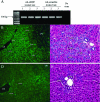Oval cell response in 2-acetylaminofluorene/partial hepatectomy rat is attenuated by short interfering RNA targeted to stromal cell-derived factor-1
- PMID: 17148669
- PMCID: PMC1762488
- DOI: 10.2353/ajpath.2006.060211
Oval cell response in 2-acetylaminofluorene/partial hepatectomy rat is attenuated by short interfering RNA targeted to stromal cell-derived factor-1
Abstract
Stromal cell-derived factor-1 (SDF-1) is known to play an essential role in the regulation of stem/progenitor cell trafficking. During hepatic stem, or oval, cell activation, SDF-1 has been reported to be up-regulated within the liver, implying a possible role in oval cell-aided liver regeneration. In the present study, SDF-1 expression was knocked down in the liver of 2-acetylaminofluorene/partial hepatectomy-treated rats using short interfering RNA delivered by recombinant adenovirus. The oval cell response was compromised in these animals, as evidenced by a decreased number of OV6-positive oval cells. In addition, knockdown of SDF-1 expression caused a dramatic decrease in alpha-fetoprotein expression, implying impaired oval cell activation in these animals. Terminal deoxynucleotidyl transferase-mediated dUTP nick-end-labeling assay showed no significant apoptosis related to SDF-1 suppression. Instead, as revealed by Ki67 immunohistochemistry, the suppression of SDF-1 resulted in decrease of hepatic cell proliferation, implying the repair process had been inhibited in these animals. These results indicate that SDF-1 is an essential molecule needed in oval cell activation.
Figures






References
-
- Evarts RP, Nagy P, Marsden E, Thorgeirsson SS. A precursor-product relationship exists between oval cells and hepatocytes in rat liver. Carcinogenesis. 1987;8:1737–1740. - PubMed
-
- Tee LB, Kirilak Y, Huang WH, Morgan RH, Yeoh GC. Differentiation of oval cells into duct-like cells in preneoplastic liver of rat placed on a choline-deficient diet supplement with ethionine. Carcinogenesis. 1994;15:4116–4124. - PubMed
-
- Petersen BE, Bowen WC, Patrene KD, Mars WM, Sullivan AK, Murase N, Boggs SS, Greenberger JS, Goff JP. Bone marrow as a potential source of hepatic oval cells. Science. 1999;284:1168–1170. - PubMed
-
- Ratajczak MZ, Kucia M, Reca R, Majka M, Janowska-Wieczorek A, Ratajczak J. Stem cell plasticity revisited: cXCR4-positive cells expressing mRNA for early muscle, liver and neural cells ‘hide out’ in the bone marrow. Leukemia. 2004;18:29–40. - PubMed
Publication types
MeSH terms
Substances
Grants and funding
LinkOut - more resources
Full Text Sources
Molecular Biology Databases

